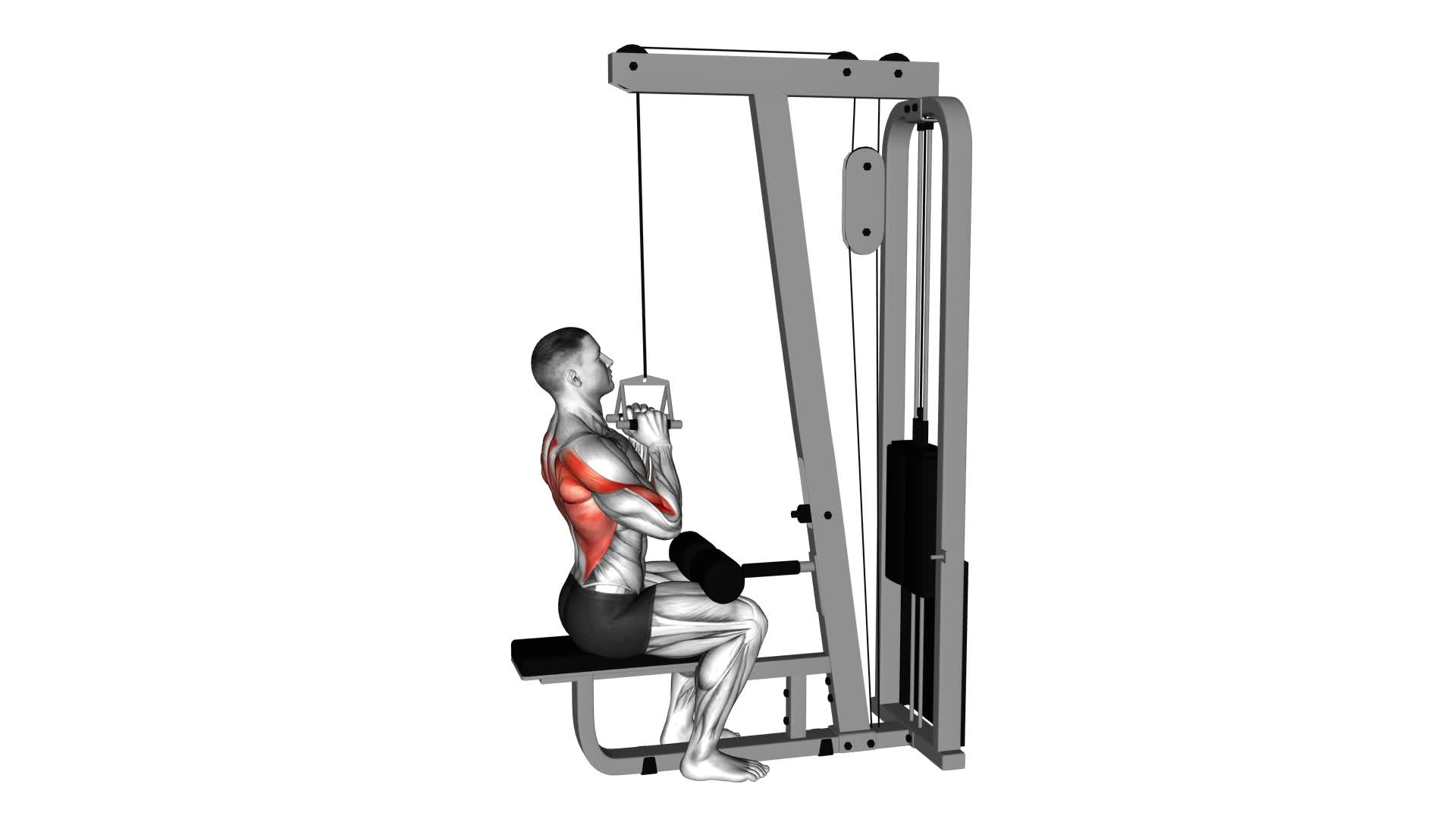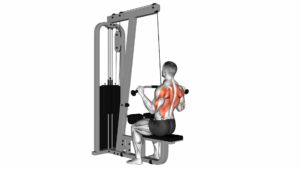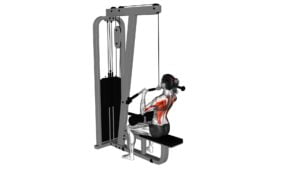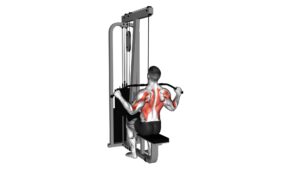Cable Lateral Pulldown With V-Bar – Video Exercise Guide & Tips

Are you looking to strengthen your back muscles and improve your upper body strength? Look no further than the cable lateral pulldown with v-bar exercise.
Watch This Exercise Video
In this video exercise guide, we'll show you the proper equipment setup, correct body positioning, and how to engage your shoulder blades for maximum effectiveness.
Avoid common mistakes and get ready to take your workout to the next level with this targeted exercise.
Let's get started!
Key Takeaways
- Proper equipment setup and body positioning are crucial for performing cable lateral pulldown with a V-bar correctly.
- Engaging the shoulder blades by retracting them and activating the upper back muscles is important for stability and range of motion.
- When performing the lateral pulldown motion, it is essential to maintain proper form, avoid common mistakes, and focus on using the back muscles.
- Benefits of cable lateral pulldown with a V-bar include targeting multiple muscles, developing a strong back, improving upper body strength and stability, and the ability to modify the exercise for different areas of the back.
Proper Equipment Setup
To properly set up the equipment for the cable lateral pulldown with V-bar exercise, attach the V-bar to the cable pulley system. Before starting the exercise, make sure to make any necessary equipment adjustments to ensure a safe and effective workout.
Adjust the height of the cable pulley system so that it's slightly higher than your head. This will allow for a full range of motion during the exercise.
Next, it's important to use the proper grip technique when using the V-bar. Place your hands evenly on the bar, with your palms facing each other. Your grip should be firm but not too tight, allowing for a comfortable and controlled movement.
By properly setting up the equipment and using the correct grip technique, you'll be able to maximize the benefits of the cable lateral pulldown with V-bar exercise.
Now, let's move on to the next section and discuss the correct body positioning for this exercise.
Correct Body Positioning
To ensure proper form and maximize the effectiveness of the cable lateral pulldown with V-bar exercise, position yourself correctly before beginning the movement. Start by sitting on the cable pulldown machine with your feet flat on the floor and your knees slightly bent. Adjust the seat height so that your thighs are parallel to the ground. Grab the V-bar attachment with an overhand grip, making sure your hands are shoulder-width apart. Keep your back straight and your chest up throughout the exercise.
Positioning your body correctly is important for several reasons. First, it ensures optimal muscle activation. By sitting upright and maintaining proper posture, you engage the muscles in your back, specifically the latissimus dorsi, which is the primary muscle targeted in this exercise. Additionally, correct body positioning helps to avoid strain on the shoulders and neck, reducing the risk of injury.
The cable lateral pulldown offers several benefits, including improved upper body strength and muscle growth. It targets the muscles in your back, helping to develop a strong and well-defined back. This exercise also engages the biceps and forearms, providing a secondary workout for those muscle groups.
Now that you understand the importance of correct body positioning, let's move on to the next section about engaging the shoulder blades.
Engaging the Shoulder Blades
Start by retracting your shoulder blades as you begin the cable lateral pulldown with the V-bar attachment. Engaging your shoulder blades is crucial for proper form and muscle activation during this exercise. Here's why:
- Shoulder blade activation: Retracting your shoulder blades helps to stabilize your shoulders and create a solid foundation for the exercise. This reduces the risk of injury and allows for a more controlled movement.
- Muscle engagement: When you retract your shoulder blades, you activate the muscles in your upper back, specifically the rhomboids and middle trapezius. This helps to target and strengthen these muscles, improving your posture and overall upper body strength.
- Improved range of motion: Engaging your shoulder blades also allows for a greater range of motion during the exercise. This means you can fully extend your arms and squeeze your shoulder blades together at the bottom of the movement, maximizing the effectiveness of the exercise.
- Increased mind-muscle connection: Focusing on retracting your shoulder blades helps you develop a stronger mind-muscle connection, allowing you to better feel and control the muscles working during the exercise.
- Enhanced results: By properly engaging your shoulder blades, you can optimize the benefits of the cable lateral pulldown, leading to improved strength, muscle tone, and overall upper body development.
Now that you understand the importance of engaging your shoulder blades, let's move on to performing the lateral pulldown motion.
Performing the Lateral Pulldown Motion
Retract your shoulder blades and initiate the lateral pulldown motion with the V-bar attachment. Start by sitting down on the cable machine with your feet flat on the floor. Adjust the knee pad so that it fits snugly against your thighs, securing your body in place. Grasp the V-bar with an overhand grip, making sure your hands are slightly wider than shoulder-width apart.
As you begin the movement, exhale and pull the V-bar down towards your upper chest. Focus on using your back muscles to pull the weight down, rather than relying on your arms. Keep your elbows pointed out to the sides and maintain a slight arch in your lower back.
To avoid common mistakes, make sure to keep your torso upright and your head in a neutral position. Avoid leaning back or using momentum to complete the exercise. Also, be mindful of not shrugging your shoulders or hunching forward.
There are several variations of the lateral pulldown exercise that you can try to target different areas of your back. For example, you can use a wide grip, close grip, or even an underhand grip with the V-bar attachment. Experiment with different grips to find what works best for you.
Remember to always use proper form and technique when performing the lateral pulldown motion. This will help you maximize the effectiveness of the exercise and reduce the risk of injury.
Common Mistakes to Avoid
One common mistake to avoid when performing the cable lateral pulldown with a V-bar attachment is allowing your elbows to drift forward as you pull the weight down. This can put unnecessary stress on your shoulders and decrease the effectiveness of the exercise.
To ensure proper form and maximize results, here are some tips to keep in mind:
- Use a controlled and smooth motion throughout the exercise.
- Maintain a neutral spine and avoid arching your back.
- Engage your core muscles to stabilize your body.
- Focus on pulling with your back muscles rather than relying solely on your arms.
- Experiment with different grip variations to target different muscles in your back.
In addition to these tips, it's important to pay attention to your breathing techniques. Exhale as you pull the weight down and inhale as you release it back up. This helps to engage your core and maintain stability throughout the movement.
Frequently Asked Questions
How Many Sets and Repetitions Should I Do for the Cable Lateral Pulldown With V-Bar Exercise?
For the cable lateral pulldown with v-bar exercise, the recommended sets and repetitions depend on your fitness level and goals. However, a good starting point is 3-4 sets of 8-12 reps.
This exercise targets your back muscles and can help improve strength and muscle definition.
Cable exercises are beneficial for the back muscles because they provide constant tension throughout the movement, allowing for better muscle activation and development.
Can I Use a Different Grip Apart From the V-Bar for the Cable Lateral Pulldown Exercise?
Yes, you can use a different grip apart from the v-bar for the cable lateral pulldown exercise.
There are various grip options and variations of cable lateral pulldown that you can try.
Experiment with different grips, such as wide grip, close grip, or underhand grip, to target different muscles in your back.
This allows you to add variety to your workout routine and engage different muscle groups for a well-rounded back workout.
Is There a Recommended Weight Range for Beginners When Performing the Cable Lateral Pulldown With V-Bar Exercise?
When performing the cable lateral pulldown with the v-bar exercise, it's recommended that beginners start with a weight range that challenges them but allows for proper form.
Start with a weight that you can comfortably perform 10-12 repetitions with for 2-3 sets.
As you progress, you can gradually increase the weight and/or the number of sets and repetitions.
Can I Perform the Cable Lateral Pulldown Exercise With a Resistance Band Instead of a Cable Machine?
Yes, you can perform the cable lateral pulldown exercise with a resistance band instead of a cable machine. Using resistance bands as an alternative provides several benefits for lateral pulldown exercises.
Resistance bands offer variable resistance, allowing you to adjust the intensity of the exercise. They also engage stabilizer muscles and improve joint stability.
Furthermore, resistance bands are portable and versatile, making them a convenient option for home workouts or when you don't have access to a cable machine.
Are There Any Variations or Modifications to the Cable Lateral Pulldown Exercise That I Can Try?
There are several variations and modifications you can try for the cable lateral pulldown exercise. These include:
- Using different grip positions, such as an underhand or overhand grip, or using a wider or narrower grip.
- Performing the exercise with one arm at a time instead of both arms together.
- Incorporating pauses or holds at different points of the movement to add difficulty and target specific muscles.
These variations can help to keep your workouts interesting and challenge your muscles in different ways.
Conclusion
In conclusion, performing the cable lateral pulldown with a v-bar is an effective exercise for targeting the back muscles.
By setting up the equipment correctly, maintaining proper body positioning, and engaging the shoulder blades, you can maximize the benefits of this exercise.
Avoiding common mistakes will ensure you perform the motion correctly and minimize the risk of injury.
Incorporating this exercise into your workout routine can help improve your back strength and overall fitness.

Author
Years ago, the spark of my life’s passion ignited in my mind the moment I stepped into the local gym for the first time. The inaugural bead of perspiration, the initial endeavor, the very first surge of endorphins, and a sense of pride that washed over me post-workout marked the beginning of my deep-seated interest in strength sports, fitness, and sports nutrition. This very curiosity blossomed rapidly into a profound fascination, propelling me to earn a Master’s degree in Physical Education from the Academy of Physical Education in Krakow, followed by a Sports Manager diploma from the Jagiellonian University. My journey of growth led me to gain more specialized qualifications, such as being a certified personal trainer with a focus on sports dietetics, a lifeguard, and an instructor for wellness and corrective gymnastics. Theoretical knowledge paired seamlessly with practical experience, reinforcing my belief that the transformation of individuals under my guidance was also a reflection of my personal growth. This belief holds true even today. Each day, I strive to push the boundaries and explore new realms. These realms gently elevate me to greater heights. The unique combination of passion for my field and the continuous quest for growth fuels my drive to break new ground.







